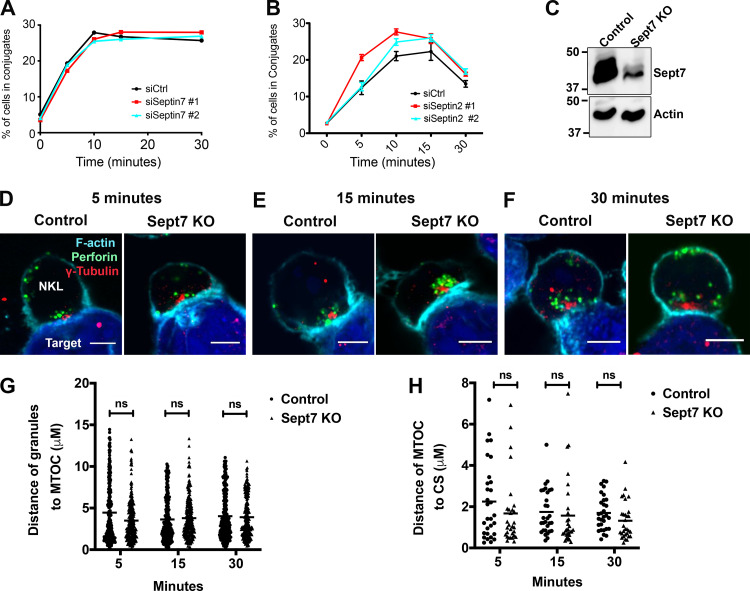Figure 4.
Depletion of septins does not impact conjugate formation, granule convergence, and MTOC polarization in NK cells. NKL cells were nucleofected with control or septin 7 or septin 2 siRNAs. (A and B) 72 h after nucleofection, NKL cells were stained with Calcein-AM and then allowed to form conjugates at 37°C with CMAC-labeled 721.221 cells over the specified times and then fixed. The formation of conjugates (CMAC + Calcein-AM+) with respect to the total number of NKL cells (Calcein-AM+) was assessed using two-color FC. Results shown are the representative of three independent experiments, each performed in triplicate. (C) NKL cells were nucleofected with either control gRNA or two different gRNAs, targeting septin 7 gene (Sept7 KO), in complex with tracrRNA and Cas9 enzyme. 96 h after nucleofection, septin 7 protein expression was assessed by immunoblotting. Immunoblot is representative of three independent experiments. (D–H) 96 h after nucleofection, NKL cells nucleofected with control or septin 7 gRNAs were incubated at 37°C with CMAC-labeled 721.221 cells (blue) for the indicated amount of time to allow conjugate formation. Cells were fixed and imaged for the location of the MTOC (γ-tubulin, red) and the location of the lytic granules (perforin, green). The periphery of the cells is defined by F-actin staining (cyan). Granule convergence was measured as the average distance between all of the perforin granules (red) within the NKL cell and the location of the MTOC marked by γ-tubulin. MTOC polarization was measured as the distance between the γ-tubulin location within the NKL cell and the nearest point of synapse with the CMAC stain. (C–F) Representative example of NKL conjugates allowed to form for 5, 15, and 30 min. Scale bar, 5 µm. (G and H) Granule convergence and MTOC polarization quantified for three independent experiments of 30–50 conjugates per group per experiment. Error bars indicate SEM. ns, not significant. Statistical significance was tested using unpaired, two-tailed Student’s t test.

